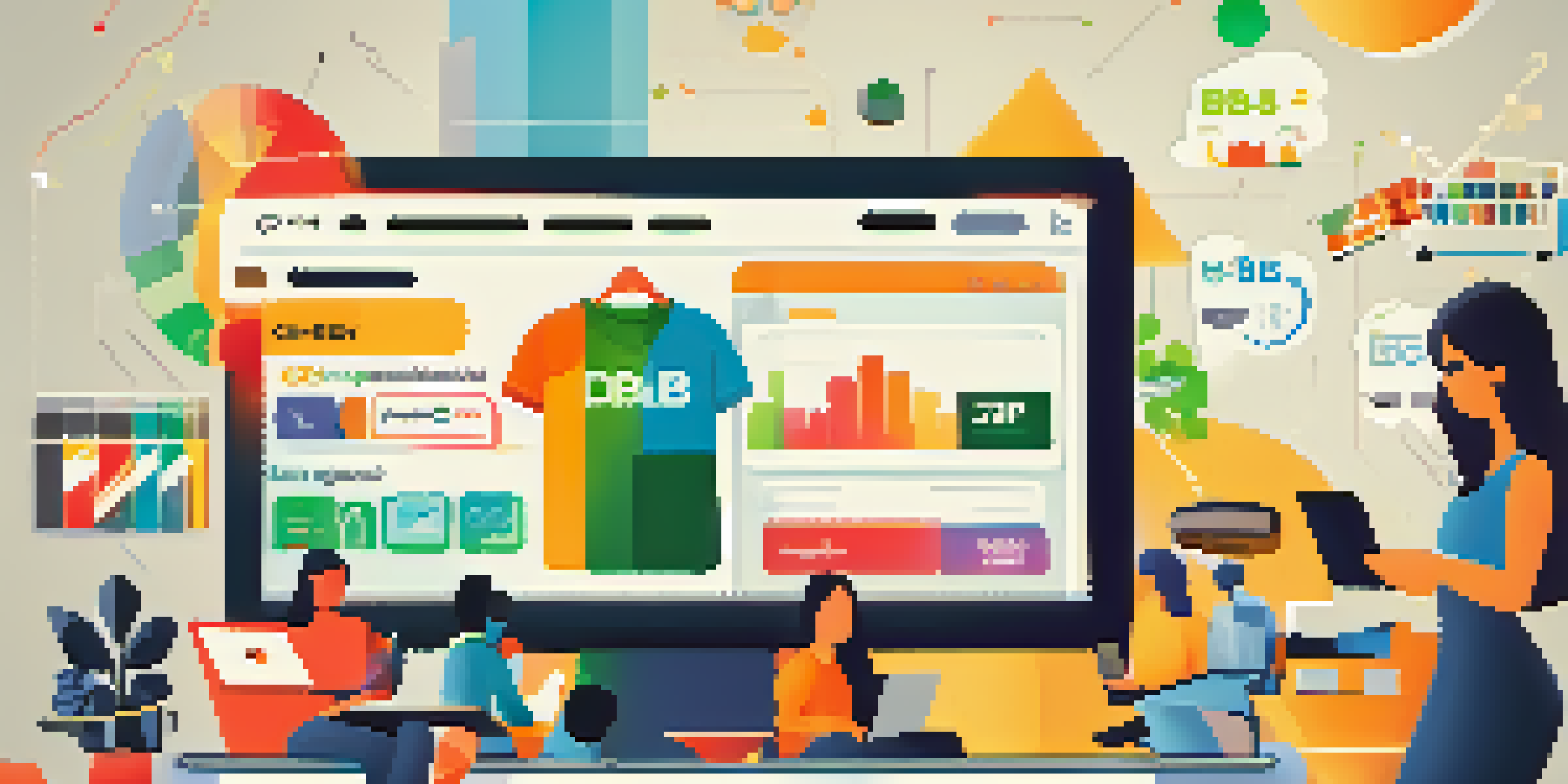Understanding E-Business Models: A Comprehensive Overview

What Are E-Business Models and Why They Matter
E-business models are frameworks that define how a company creates, delivers, and captures value online. They serve as the blueprint for online operations, outlining strategies for revenue generation, target audiences, and value propositions. Understanding these models is crucial because they shape the way businesses interact with customers and stakeholders in the digital landscape.
In the age of digital transformation, companies must constantly innovate their business models to meet the evolving needs of their customers.
For instance, consider Amazon, which uses a combination of retail and subscription models to drive sales and customer loyalty. This blend allows them to cater to various consumer needs while maximizing their market reach. By grasping the nuances of different e-business models, entrepreneurs can better position their ventures for success in an increasingly competitive online environment.
Moreover, knowing the right model can help businesses adapt to changing market conditions, ensuring longevity and resilience. As digital trends evolve, so too should the strategies that underpin these models, making continuous learning vital for any business aiming to thrive online.
Business-to-Consumer (B2C) Model Explained
The Business-to-Consumer (B2C) model is one of the most recognized e-business frameworks, where businesses sell products or services directly to consumers. This model thrives in the world of e-commerce, with popular examples like online retailers and streaming services. The straightforward nature of B2C transactions makes it easy for customers to browse, compare, and purchase with just a few clicks.

Take Netflix as an example; it provides streaming services directly to consumers through a subscription model. This not only enhances customer experience but also fosters loyalty as users become accustomed to the convenience of on-demand content. The success of B2C largely hinges on understanding customer preferences and tailoring offerings to meet those needs.
E-Business Models Define Strategies
E-business models serve as blueprints for how companies create, deliver, and capture value online.
As technology continues to advance, B2C businesses must adapt by implementing personalized marketing strategies and enhancing user experiences. By doing so, they can build strong relationships with their customers, ultimately leading to increased sales and brand loyalty.
Understanding Business-to-Business (B2B) Models
In contrast to B2C, the Business-to-Business (B2B) model focuses on transactions between businesses. This model often involves larger order volumes and longer sales cycles, as companies typically invest heavily in products and services that enhance their own operations. B2B e-commerce platforms, like Alibaba, exemplify this model by connecting manufacturers with retailers.
The greatest danger in times of turbulence is not the turbulence; it is to act with yesterday's logic.
A practical example is a software company that provides solutions to other businesses, such as CRM systems or project management tools. These products are designed to streamline operations and improve efficiency, making them invaluable to their clients. B2B relationships are often built on trust, quality, and long-term partnerships, which can lead to repeat business and referrals.
As businesses increasingly move online, B2B models are evolving to include digital marketplaces and automated procurement processes. To stay competitive, B2B companies must prioritize customer service and adapt their offerings to meet the unique needs of their business clients.
Exploring Consumer-to-Consumer (C2C) Models
The Consumer-to-Consumer (C2C) model allows individuals to sell products and services directly to one another, typically facilitated by online platforms. Websites like eBay and Craigslist enable users to list items for sale, creating a marketplace driven by peer-to-peer transactions. This model promotes accessibility and affordability, allowing consumers to find unique products at competitive prices.
A great example of C2C in action is Etsy, where artisans sell handmade goods directly to consumers. This platform empowers small creators and fosters a sense of community among buyers and sellers. C2C models rely heavily on trust and reputation, as users often depend on reviews and ratings to gauge the reliability of transactions.
B2C Enhances Customer Experience
The B2C model focuses on direct sales to consumers, improving convenience and fostering loyalty through tailored experiences.
As C2C platforms continue to grow, they challenge traditional retail models by offering consumers more control over pricing and product selection. However, maintaining safety and trust is essential for these platforms to thrive, necessitating robust policies and user education.
Introducing Business-to-Government (B2G) Models
The Business-to-Government (B2G) model involves businesses providing goods or services to governmental entities. This model can encompass a wide range of industries, from construction and IT services to consulting and healthcare. B2G transactions often require businesses to navigate complex regulations and bidding processes, making this model distinct from B2B and B2C.
For example, consider a technology firm that develops software for public sector agencies. These companies often need to adhere to strict compliance standards while demonstrating their ability to deliver high-quality solutions. Successful B2G businesses often establish strong relationships with government officials, leading to repeat contracts and collaborations.
As governments increasingly turn to digital solutions, the B2G model is evolving to incorporate e-procurement platforms and other online tools. Businesses must stay informed about governmental needs and adapt their offerings accordingly to capitalize on this growing market.
Diving Into Business-to-Employee (B2E) Models
The Business-to-Employee (B2E) model focuses on the relationship between businesses and their employees, often involving the provision of goods and services to enhance employee satisfaction and productivity. This model can include benefits like employee discounts, training programs, and internal marketplaces. B2E strategies aim to improve employee engagement and retention, ultimately benefiting the organization as a whole.
For instance, many companies offer online learning platforms for their employees to develop new skills. This not only empowers employees but also adds value to the organization by creating a more skilled workforce. By investing in their employees, businesses foster loyalty and create a positive work culture.
Adapting Models for Future Success
Continuous learning and innovation in e-business models are crucial for staying relevant and meeting evolving customer needs.
As remote work becomes more prevalent, B2E models are evolving to include digital tools and resources that support employee well-being. Organizations must stay attuned to their employees' needs and leverage technology to create a supportive and engaging work environment.
The Rise of Subscription-Based E-Business Models
Subscription-based e-business models have gained immense popularity in recent years, offering consumers access to products or services for a recurring fee. This model can be seen in various industries, from streaming services like Spotify to subscription boxes like Birchbox. The allure of subscriptions lies in their convenience and the promise of continuous value delivery.
For example, meal kit delivery services provide customers with pre-portioned ingredients and recipes for a weekly fee, simplifying the cooking process. This not only saves time but also encourages consumers to try new recipes and ingredients. Subscription models benefit businesses by creating predictable revenue streams and fostering customer loyalty.

As more companies adopt subscription models, it's essential for them to deliver consistent quality and innovate to retain subscribers. By focusing on customer satisfaction and adapting to changing preferences, businesses can thrive in the competitive subscription landscape.
Conclusion: Adapting E-Business Models for the Future
In conclusion, understanding various e-business models is vital for anyone looking to succeed in the digital marketplace. Each model offers unique benefits and challenges, influencing how businesses engage with their customers and generate revenue. By exploring these models, entrepreneurs can identify the best fit for their goals and target audience.
As technology continues to evolve, so too will these models, requiring businesses to remain agile and adaptable. Continuous learning and innovation will be key to staying relevant in a fast-paced digital landscape. Entrepreneurs must not only embrace change but also anticipate future trends to maintain a competitive edge.
Ultimately, the success of an e-business model hinges on understanding customer needs and building strong relationships. By prioritizing value creation and customer experience, businesses can thrive in the ever-changing world of e-commerce.